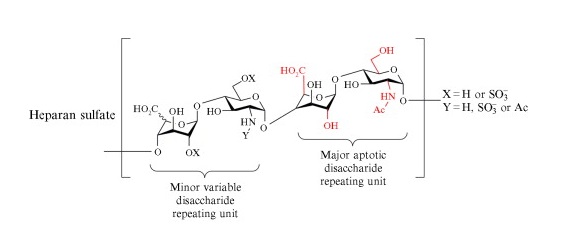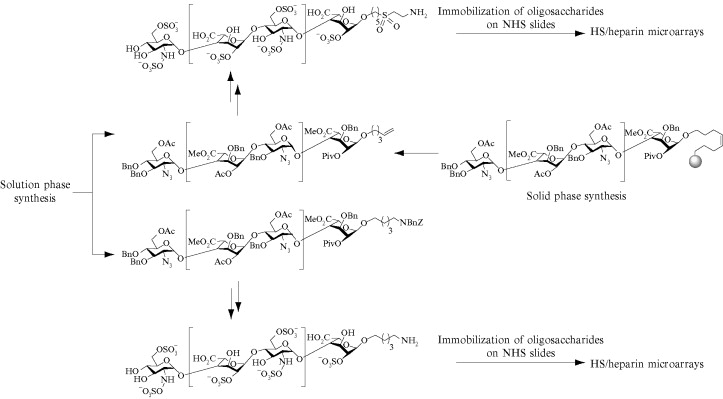Heparin Sulfate Microarray Service
- Protein-HS Interaction Studies
- Antibody and Vaccine Design
- Tumor Mechanism and Biomarker Discovery
- Lead Compound Screening
- Structural Biology and Mechanistic Studies
Heparin Sulfate Microarray Service is a microarray-based analytical service designed to study the interactions between heparan sulfate (HS) and various biomolecules. In this service, HS oligosaccharides or polymers with distinct sulfation patterns and degrees of polymerization are covalently immobilized onto solid supports (such as glass slides or microarray chips), enabling the investigation of HS interactions with proteins, peptides, or small molecules.

Yin J, Seeberger PH. Methods Enzymol. 2010.
Figure 1. Major and minor disaccharide repeating units in heparan sulfate.
HS is a highly sulfated glycosaminoglycan (GAG) widely distributed on the cell surface and within the extracellular matrix. HS consists of alternating units of glucosamine and uronic acid, and undergoes extensive N- and O-sulfation, resulting in structurally heterogeneous polysaccharide chains. This structural diversity not only determines its binding specificity but also underlies its irreplaceable biological functions in numerous physiological and pathological processes.
Studies have shown that HS binds specifically to a wide range of proteins, peptides, small molecules, and even pathogenic agents through its anion-rich domains. These interactions regulate key biological processes such as cell proliferation, differentiation, migration, chemotaxis, viral entry, and tumor metastasis. Therefore, systematically characterizing the interaction profiles between HS and its ligands is essential for understanding the regulatory roles of the extracellular "glycocode," identifying novel therapeutic targets, and developing GAG-targeted drugs. Unlike traditional one-to-one binding assays, the microarray platform enables simultaneous profiling of hundreds of distinct HS structures within a single experiment, offering a comprehensive view of glycosaminoglycan-dependent regulatory mechanisms.
MtoZ Biolabs offers Heparin Sulfate Microarray Service to not only reveal the binding spectrum between target molecules and HS, but also to characterize structural preferences, affinity variations, and potential binding sites. This provides critical data to support mechanistic research and translational applications.
Services at MtoZ Biolabs
MtoZ Biolabs' main services in the Heparin Sulfate Microarray Service are as follows:
Multi-Type Ligand Interaction Profiling
Screen the binding of proteins, peptides, and small molecules against diverse heparan sulfate variants, supporting pathway analysis and novel target discovery.
Affinity and Kinetics Assessment
Estimate binding strength (Kd) and kinetic rate constants (kon/koff) through high-resolution array signal responses, providing insights into interaction mechanisms and stability.
Structure-Activity Relationship (SAR) Analysis
Systematically evaluate how different sulfation patterns of HS variants influence ligand binding, supporting structural optimization and functional characterization.
Custom Microarray Design
Support flexible array configuration with various HS variants and site-specific immobilization; ligand types and detection formats can be tailored to project needs.
Data Analysis and Interpretation
Deliver standardized signal processing, statistical analysis, and visual outputs, combined with functional annotation and mechanism prediction to guide downstream research.

Yin J, Seeberger PH. Methods Enzymol. 2010.
Figure 2. A general method for the preparation of microarrays containing synthetic HS/heparin oligosaccharides.
Service Advantages
High Sensitivity with Low Background: Capable of detecting weak binding signals, making it ideal for screening low-affinity ligands.
High-Throughput Screening Platform: Enables evaluation of hundreds of ligand-HS binding events within a single experiment.
Highly Customizable: Supports personalized design across multiple dimensions, including HS structure, ligand type, and detection method.
Comprehensive Data Support: Delivers visualized results and bioinformatics interpretation to facilitate downstream research decisions.
Broad Research Applications: Applicable to glycobiology, target discovery, disease mechanism studies, and novel drug development.
Sample Submission Suggestions
We accept various types of ligand samples, including proteins, peptides, and small-molecule compounds. High-purity samples free from inhibitors or interfering impurities are recommended. Depending on experimental requirements, fluorescent or biotin labeling may be applied.
If labeling is needed or you are unsure about sample compatibility, please contact the MtoZ Biolabs technical team for a personalized sample preparation guide.
Applications
Identify binding sites and structural dependencies between HS and transcription factors, chemokines, or growth factors.
Characterize the binding patterns between viral surface proteins and host HS to support antibody screening and vaccine optimization.
Analyze protein-HS interactions within the tumor microenvironment to uncover potential diagnostic targets.
Identify small molecules or peptide-based drug candidates with HS-binding activity to support antiviral and anticancer drug development.
Compare how different HS sulfation sites influence binding characteristics to support structure-activity relationship (SAR) modeling.
Deliverables
1. Comprehensive Experimental Details
2. Materials, Instruments, and Methods
3. Total Ion Chromatogram & Quality Control Assessment (project-dependent)
4. Data Analysis, Preprocessing, and Estimation (project-dependent)
5. Bioinformatics Analysis
6. Raw Data Files
Related Services
How to order?







